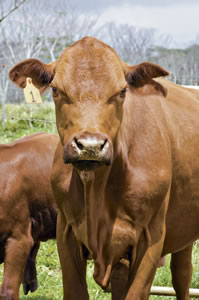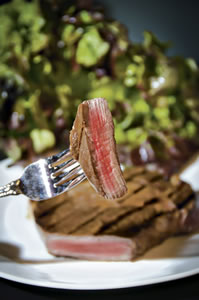Grass Makes For Great Steaks
Duane Shimogawa Sr. raises 100 percent all-natural, grass-fed cows that graze on 1,600 acres of pristine Kaua`i pasture. A`akukui Ranch’s beef is hormone and antibiotic free.GRASS-FED STEAK
A cow’s natural diet is grass, not grain, and a cow’s natural environment is a pasture, not a feedlot. Unless the label says grass-fed, you’re getting grain-fed beef that’s likely raised in a feedlot. America has gotten used to feedlot cows with their flesh made tender by immobility and too many corn-fed calories.
Grass-fed cattle have solid muscle tissue because they graze the hillsides, munching on blades of grass. This means it takes a little extra care to serve up a steak that is tender and juicy. Since grass-fed beef is sustainably raised, better for your health, and has more flavor, it’s worth the effort.
Shimogawa prefers retailers to age his beef up to 21 days before it’s sold. Aging is a process that breaks down the connective tissue, and makes the beef tender while concentrating the flavor. Ask your retailer if the steak is aged, and for how long.
Season: Even though the growing conditions on Kaua`i encourage grass to grow year-round, enabling Shimogawa to provide beef all year, 60 percent of the cattle are born in the spring. It takes two years from birth to slaughter.
What to look for: Shimogawa’s beef sells fast, so that means you’ll get beef that was processed a day or two before, unlike beef that has traveled thousands of miles to get here. A deep-red color, clean scent and firm texture means it’s fresh. Brown spots are an indication of age, and not in a good way.
Storage: Store in the refrigerator for up to three days, freeze for one month, or try this tip Shimogawa shared with me:At home, Shimogawa ages his steak by vacuum sealing cuts of beef and storing them in the refrigerator for at least 15 days. He warns that the bone in some cuts may pierce the bag while the air is being drawn out, and recommends putting a piece of folded plastic over the bone before vacuum sealing it.
Preparation: When cooking grass-fed steak, less cooking time is better. For a rare steak, three minutes per side will do. Medium-rare requires four minutes per side. If you like your steak cooked above medium-rare, this is not for you. Cooking it over four minutes will make it tough.
Take the steak out of the refrigerator 30 minutes before you cook it. This gives it time to come to room temperature so it will cook more evenly.
You want to cook over high heat. If you don’t have a grill, you can buy a pre-seasoned cast iron grill pan at Macy’s for $25. Set the pan over medium heat for 5 minutes. Just before you add the steak, turn it up to medium-high. The idea is to have the steak sizzle once you put it in the pan. Set your timer accordingly.
Take the steak out of the pan, and let it rest for eight minutes. This allows the juices to reabsorb into the muscle tissue. If you cut into it sooner, then all that yummy juice will end up on the cutting board, and you’ll have a dry steak. For best results, slice thinly across the grain.
Health benefits: Researchers at S. Larson College of Agriculture, California State University, and Chico University of California Cooperative Extension Service believe that increases in chronic disease aredirectly related to the change in our dietary patterns over the last 200 years.Our ancestors consumed an omega-6:omega-3 ratio of 1:1, and today’s habits are closer to 10-20:1. These researchers believe the ideal omega-6 intake should be no more than 4-5 times that of our omega-3 intake.
The study states, “As with the human diet, cattle feed or the composition of the ration has a significant effect on the fatty acid profile of the final beef product. Cattle fed primarily grass enhanced the omega-3 content of beef by 60 percent and also produces a more favorable omega-6 to omega-3 ratio.”
A`akukui Ranch beef can be found at:
Grocery: Ishihara Market, Sueoka Store, Kukuiula Market. Restaurants: Hukilau Lanai, Oasis on the Beach, and Kauai Pasta, Lihu`e. Call 245-2450 for details.
HUKILAU LANAI’S MARINADE
“There are two schools of thought on cooking grass fed beef,” says Ron Miller, owner and executive chef of Hukilau Lanai. “One is to keep it simple, with a nice coating of Hawaiian sea salt and seared rare. This highlights the natural grass flavors of locally raised beef. Another is to enhance the flavors with a marinade. I think both are appropriate.”
This is the marinade recipe that Hukilau Lanai uses for local meat. Makes just over 4 cups.
2 cups soy sauce
1 1/2 cups rice vinegar
3/4 cup ketchup
1 tablespoon paprika
2 teaspoons garlic powder
Mix well. Put one steak in a freezer bag, add 1/2 cup marinade and store in refrigerator overnight, up to 24 hours. Store the rest of the marinade in a tightly sealed jar, in the refrigerator, for up to a month. If you are cooking more than one, add an additional 1/2 cup marinade to bag, per steak. Prepare according to directions above. To get a nice crust, rinse off the marinade, and pat dry before cooking.






